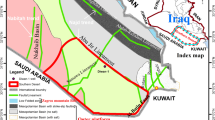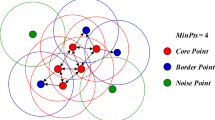Abstract
In 3D gravity inversion, a regularization technique must be introduced in order to deal with the non-uniqueness and stability of the inversion process. For this purpose, stabilizing functionals based on minimum norm and maximum smoothness have been utilized as the regularization item in the objective function of gravity inversion, but yield a smoothed distribution of subsurface density which does not give a clear delineation of the boundaries of blocky geological units. Although some functionals such as minimum support and minimum gradient support functionals have been applied to focusing inversion of potential field data, these functionals need to be provided with a suitable focusing parameter for successful inversion. In this paper, we have developed a focusing 3D inversion of gravity data based on an arctangent stabilizing functional. To deal with the numerical solution to the gravity inversion problem, the arctangent-function-based stabilizing functional is first reformulated in pseudo-quadratic form as a weighting matrix. The Gauss Newton (GN) minimization scheme is then employed to perform an optimization process. For the stabilizing functional introduced in this study, there is no need to determine in advance two optimum parameters involved in the stabilizing functional. A test on synthetic examples demonstrates that the boundaries of the anomalous bodies recovered are sharper and the density values are also closer to the true model. We also apply this approach to field gravity data collected from the San Nicolas deposit in Mexico, illustrating that the inversion result shows good consistency with the a priori information available.













Similar content being viewed by others
References
Bertete-Aguirre, H., Cherkaev, E., & Oristaglio, M. (2002). Non-smooth gravity problem with total variation penalization functional. Geophysical Journal International, 149(2), 499–507.
Blakely, R. J. (1995). Potential theory in gravity and magnetic applications. Cambridge University Press.
Boulanger, O., & Chouteau, M. (2001). Constraints in 3D gravity inversion. Geophysical Prospecting, 49(2), 265–280.
Čuma, M., Wilson, G. A., & Zhdanov, M. S. (2012). Large-scale 3D inversion of potential field data. Geophysical Prospecting, 60(6), 1186–1199.
Farquharson, C. G. (2008). Constructing piecewise-constant models in multidimensional minimum-structure inversions. Geophysics, 73(1), K1–K9.
Fedi, M., & Rapolla, A. (1999). 3-D inversion of gravity and magnetic data with depth resolution. Geophysics, 64(2), 452–460.
Hu, S., Zhao, Y., Qin, T., Rao, C., & An, C. (2017). Traveltime tomography of crosshole ground-penetrating radar based on an arctangent functional with compactness constraints. Geophysics, 82(3), H1–H14.
Kirkendall, B., Li, Y., & Oldenburg, D. (2007). Imaging cargo containers using gravity gradiometry. IEEE Transactions on Geoscience and Remote Sensing, 45(6), 1786–1797.
Last, B. J., & Kubik, K. (1983). Compact gravity inversion. Geophysics, 48(6), 713–721.
Lelièvre, P. G., Oldenburg, D. W., & Williams, N. C. (2009). Integrating geological and geophysical data through advanced constrained inversions. Exploration Geophysics, 40(4), 334–341.
Li, Y., & Oldenburg, D. W. (1998). 3-D inversion of gravity data. Geophysics, 63(1), 109–119.
Li, Z. L., Yao, C. L., & Zheng, Y. M. (2019). 3D inversion of gravity data using Lp-norm sparse optimization. Chinese Journal of Geophysics, 62(10), 3699–3709.
Marchetti, P., Coraggio, F., Gabbriellini, G., Ialongo, S., & Fedi, M. (2014). Large-scale 3D gravity data space inversion in hydrocarbon exploration. In 84th annual international meeting, SEG (pp. 1269–1274).
Meng, Z. (2018). Three-dimensional potential field data inversion with L0 quasinorm sparse constraints. Geophysical Prospecting, 66(3), 626–646.
Peng, G., Liu, Z., Xu, K., Bai, Y., & Du, R. (2018a). Efficient 3D inversion of potential field data using fast proximal objective function optimization algorithm. Journal of Applied Geophysics, 159, 108–115.
Peng, G. M., Liu, Z., Yu, H. Z., Xu, K. J., & Chen, X. H. (2018b). 3D gravity inversion based on Cauchy distribution constraint and fast proximal objective function optimization. Chinese Journal of Geophysics, 61(12), 4934–4941.
Phillips, N., Oldenburg, D., Chen, J., Li, Y., & Routh, P. (2001). Cost effectiveness of geophysical inversions in mineral exploration: Applications at San Nicolas. The Leading Edge, 20(12), 1351–1360.
Pilkington, M. (2009). 3D magnetic data-space inversion with sparseness constraints. Geophysics, 74(1), L7–L15.
Portniaguine, O., & Zhdanov, M. S. (1999). Focusing geophysical inversion images. Geophysics, 64(3), 874–887.
Portniaguine, O., & Zhdanov, M. S. (2002). 3-D magnetic inversion with data compression and image focusing. Geophysics, 67(5), 1532–1541.
Rezaie, M. (2019). 3D non-smooth inversion of gravity data by zero order minimum entropy stabilizing functional. Physics of the Earth and Planetary Interiors, 294, 106275.
Sun, J., & Li, Y. (2014). Adaptive Lp inversion for simultaneous recovery of both blocky and smooth features in a geophysical model. Geophysical Journal International, 197(2), 882–899.
Vatankhah, S., Renaut, R. A., & Ardestani, V. E. (2018). Total variation regularization of the 3-D gravity inverse problem using a randomized generalized singular value decomposition. Geophysical Journal International, 213(1), 695–705.
Zhao, C., Yu, P., & Zhang, L. (2016). A new stabilizing functional to enhance the sharp boundary in potential field regularized inversion. Journal of Applied Geophysics, 135, 356–366.
Zhdanov, M. S. (2015). Inverse theory and applications in geophysics. Elsevier.
Acknowledgements
This research is financially supported by the National Natural Science Foundation of China (Grant No. 42004054) and the National Key Research and Development Program of China (Grant No. 2018YFC0603300). The authors would like to thank two anonymous reviewers for their comments that significantly improved this manuscript. We also thank the Geophysical Inversion Facility of the University of British Columbia for the real gravity data available publicly.
Author information
Authors and Affiliations
Corresponding author
Additional information
Publisher's Note
Springer Nature remains neutral with regard to jurisdictional claims in published maps and institutional affiliations.
Rights and permissions
About this article
Cite this article
Peng, G., Liu, Z. 3D Focusing Inversion of Gravity Data Based on an Arctangent Stabilizing Functional. Pure Appl. Geophys. 178, 2191–2200 (2021). https://doi.org/10.1007/s00024-021-02760-9
Received:
Revised:
Accepted:
Published:
Issue Date:
DOI: https://doi.org/10.1007/s00024-021-02760-9




